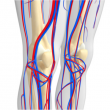Published 5-year results had been neutral for bilateral vs. single internal-thoracic artery grafts, but, at the time, surgeons argued that the time period analyzed was not enough and that a difference would be observed after 10 years of follow-up, once the trial finished. Such follow-up was presented at the European Society of Cardiology (ESC) Congress 2018...
FFR vs Angiography Guided CABG
In the daily practice and in randomized studies such as Syntax or Freedom, most cardiovascular surgeons across the world use angiography guided CABG to teat 50% coronary stenosis. Many of these lesions might not be functionally significant. There is abundant evidence in favor of fractional flow reserve (FFR) guided PCI, but FFR guided CABG is...
TAVR with Prior MRS: A New Challenge
The benefits of transcatheter aortic valve replacement (TAVR) for high-risk, prohibitive-risk (class I) or intermediate-risk (class IIa) patients have already been proven, but there is a growing population of patients with a history of myocardial revascularization surgery (MRS) who experience severe aortic stenosis. Decision-making in these cases is anything but simple, mainly due to the presence of...
TAVR in Patients with Classical Low Flow, Low Gradient
Classical symptomatic low-flow, low-gradient (LFLG) severe aortic stenosis is associated with low survival rates at 3 years (<50%). However, in the medium term and with surgery, those rates improve (although mortality rates are 6%-30%, depending on the series). In patients without contractile reserve, surgical mortality is higher. Patient evolution in TAVR is still mostly unclear. ...
What’s New in the European Guidelines on Peripheral Arterial Disease
Since the last version of the European guidelines on the diagnosis and treatment of peripheral arterial disease in 2011, there have been many trials and registries that warrant guideline adjustments in many aspects. The first novelty is the teamwork that gave way to these guidelines, which were written in collaboration with the European Society of...
Routine FFR/iFR Reclassifies Treatment Strategies in Half of Cases
Routine invasive physiology assessment at time of angiography reclassifies treatment strategies in a big number of patients with lesions in 2 or 3 vessels, according to the multicenter prospective study DEFINE REAL, recently published in JACC Cardiovascular Interventions. The information obtained by measuring fractional flow reserve (FFR) or instantaneous wave free ratio (iFR) made interventionists modify their original plans in...
Who Lives Longer After TAVR, Men or Women?
Courtesy of Dr. Carlos Fava. Currently, some small observational studies and a meta-analysis suggest that women experience more short-term complications after TAVR (due to higher rates of bleeding, vascular complications, and stroke), as well as less 1-year mortality. However, results are still conflicting. This work analyzed 17 studies including 8 different registries, with a total 23,303 women and 23,885 men....
These were the 5 most read scientific articles of January
1) The 10 Commandments of ESC’s New STEMI Guidelines The authors have given an entertaining account of the most relevant points and differences between the new STEMI guidelines and the prior ones, from 2014. Read more 2) Burnout Syndrome among Cardiologists For the first time, the American College of Cardiology (ACC) has carried out a survey on this phenomenon,...
The 9 most read scientific articles of 2017 in interventional cardiology
1) New High Blood Pressure Guidelines The wait is finally over: the high blood pressure guidelines that have been in the works for the past 3 years saw the light of day at the American Heart Association (AHA) 2017 Scientific Sessions. Read more 2) Nearly half of interventional cardiologists may have pre-cataract lesions This statement is based on eye...
Coronary Angioplasty Is a Valid Alternative for Left Main Coronary Artery Disease
Courtesy of Dr. Carlos Fava. Severe left main coronary artery (LMCA) lesions have a bad prognosis in coronary disease. In that scenario, current guidelines recommend surgery as the treatment of choice. However, due to the current development of second-generation drug-eluting stents (DES) and greater operator expertise, left main coronary artery angioplasty appears as a valid alternative...









